Connie Bombaci's Blog, page 2
December 10, 2021
Holiday Tips Revisited
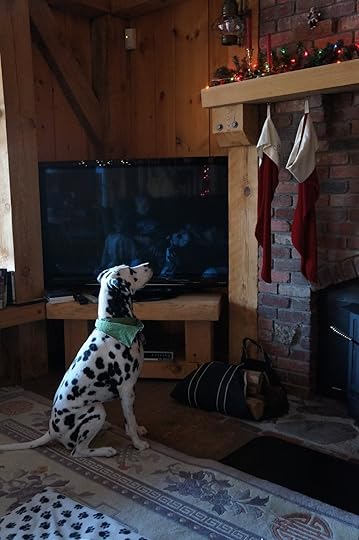
Santa is coming!
Judea always loved seeing her stocking hung on the mantle. She anxiously awaited getting her very special treats from Santa.
Shoreline Animal Hospital’s Pet Holiday Safety Tips
The veterinarians at Shoreline Animal Hospital, Dr. Julie Berman, Dr.Michelle West, and Dr. Lynda Perry want to wish all pet owners in Clinton safe and happy holidays. To help ensure the holidays are safe for all pets, they are sharing holiday safety tips to prevent serious illness or injury.
Oh, Christmas Tree: Securely anchor your Christmas tree to prevent tipping from curious feline family members. If you have a live tree, securing your tree will keep stagnant water from spilling, that could contain fertilizers and bacteria. Wrapped gifts under the tree, such as boxes of chocolate could also be dangerous if Fido follows his nose and opens them on his own, so keep them out of reach until after Santa comes.
Sparkly Tinsel: Kitties can find tinsel and ribbons irresistible to play with and carry in their mouths. Ingestion can lead to bowel obstruction, severe vomiting, dehydration,and could require surgery.
Holiday Treats: Your holiday guests might want to slip treats to your pets, and holiday leftovers might be tempting for Rover to steal. Fatty and spicy foods, bones,raw bread dough, alcoholic beverages, onions/ garlic, chocolate, and grapes are on the please do not feed list! A well-intended treat could trigger GI upset, diarrhea or pancreatitis. Sugar free sweets could contain xylitol that can be lethal to pets. If your guests want to give some extra attention to your pets they can provide a walk or some extra cuddle time.
Nostalgic Snow Globes: Snow globes may contain ethylene glycol, (also found in anti-freeze) which is a highly toxic substance if ingested. If a snow globe is broken the sweet smell can attract a pet to lick it up, leading to potentially fatal intoxication. Please keep all snow globes out of reach of pets.
Open Suitcases: Family pets often like to investigate your visitors’ suitcases. Pets can get into pill vials and weekly pill reminder cases. Please remind your guests to secure all medications in a cabinet and to close their suitcases!
New Year’s Celebrations: New Year’s Eve noises from poppers to fireworks can be terrifying for pets. Please be sure to provide your pets an escape proof area that is quiet with fresh water and places to snuggle as midnight approaches
November 19, 2021
Hogan’s Hope for a Safe Thanksgiving with our Deaf Dogs -- All Our Dogs
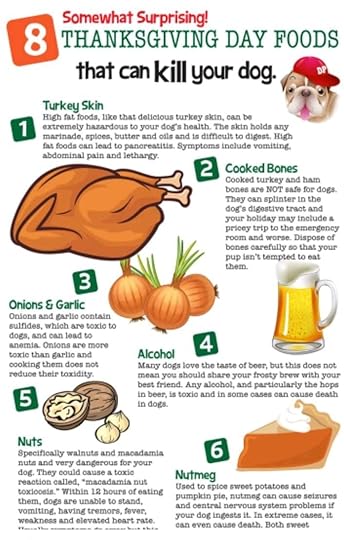
More warnings below.
Much appreciation to the person or organization that designed this wonderful picture!
Thanksgiving is less than a week away and holiday guests might want to slip treats to our pets. Not only that, but holiday leftovers might be tempting for our precious animals to steal. Fatty and spicy foods, bones, raw bread dough, alcoholic beverages, onions/ garlic, chocolate, grapes, and raisins are on the please do not feed list!
A well-intended treat could trigger intestinal upset, diarrhea, or even pancreatitis. Sugar-free sweets could contain xylitol that can be lethal to pets. If guests want to give some extra attention to our pets, they can provide a walk or some extra cuddle time. As the human caretakers, we are responsible for our precious pups’ needs and safety. We can provide healthy and safe alternatives that our animals will love, and our guests will feel happier being able to spoil a loving, warm, and furry family member who is insisting on getting a treat as everyone else.
Please be extra diligent during this festive season when our parties and gatherings can turn upside-down if our beloved pets become ill or even worse. Let everyone know that positive reinforcement is the only option and each person must know how to approach, get attention, and how to handle situations, even if that means getting you to take care of things.
Be sure to have special treats on hand like baby carrots, small pieces of apple, or special dog treats.
Keep food up where our four-legged family members can’t reach. Our deaf pups can’t hear us telling them from behind that their behavior isn’t appropriate.
Instruct children, seniors, and guests on what not to feed our pets. Humans need to be diligent to keep our deaf dogs’ attention focused and our communication visible.
Tethering your pup to your side is a great way to keep them close and under a watchful eye. This practice also helps keep negative correction out of the equation because our pups have to pay much closer attention.
Happy Thanksgiving, and let’s make certain that it’s all happy for everyone!
Another list helps list dangerous items:
September 25, 2021
Hogan’s Hope always on the lookout for better work with our deaf dogs.

I have been working with deaf dogs since late 1993 when Hogan came to be a permanent member of our family. Being that he was deaf and surrounded by so many negative myths, I have always been sensitive to the claims of others, the things they believe are true, and the good ways to better live with our deaf animals. This article caught my interest and I copy it below for you to read.
I must share with you, however, that I do not agree with everything offered. For instance, Dr. Strain states, “While deaf dogs are more difficult to raise and train and can bite when startled, there are strategies for living with them.”
During my work with thousands of families worldwide, I have found more times than not that the “difficulty” was the human. Once solid communication was established, the success rate soared. All of my own deaf pups have trained easier than most of my hearing dogs which I attribute to the bond, focus, and need to watch my hands, expressions, and movements carefully. Training, except for the method of communication, is basically the same for the deaf and hearing dogs. Safety is always an important issue and we must be diligent. Desensitization to being startled is critical for hearing and deaf dogs as well as safeguarding them from running out into traffic.
I have had the honor to consult and work with Dr. Nicholas Dodman, the internationally renowned animal behaviorist at Tufts University. He was enamored with our Hogan and the fact that our special pup could understand American Sign Language. — Why reinvent the wheel? Let many folks talk with our deaf dog, making it very convenient to establish better socialization. — The KEY is communication!
Read for yourself and glean important information. Our deaf dogs deserve the best of everything, and we humans must take serious responsibility for their care.
[image error] Dog eared: LSU vet school expert helps determine if pets are deaf and what to do about itBY SANDRA SARR Contributing writer
AUG 30, 2021 - 7:00 AM
Once, the moment your key turned in the lock, your dog was there to greet you. Or, if someone stepped on to the porch, your pooch barked an alarm.
Lately, however, Fido hasn't mustered from his spot whether it's a treat bag shaking or a leash coming off the hook.
The problem could be he or she can't hear.
That's what happened with Luna. Shortly after Francesca Vega and Amado Aguayo moved to Lafayette, they noticed Luna began behaving differently. She would flinch when they approached from behind to pet her. She no longer got up to greet them when they entered the house after work.
They brought Luna to George Strain, an expert in deafness in dogs and cats and a professor of veterinary physiology, pharmacology and toxicology at the LSU School of Veterinary Medicine.
Strain tests dogs to measure their nervous systems’ response to acoustic stimulation. Luna’s test results showed she was 100% deaf in both ears.
“It has made a difference to know definitively that Luna is deaf," Vega said. "Now, we can make adjustments to help her for the rest of her life.”
The 5-year-old, 100-poung Malamute-husky mix has been with the couple since she was 11 weeks old. They recalled that she was difficult to train, and now suspect she may have had some hearing problems all along.
While deaf dogs are more difficult to raise and train and can bite when startled, there are strategies for living with them.
“Deaf dogs cope well, generally," Strain said. "It’s important to protect them from cars and situations where they may be startled. Any startled dog can bite, and deaf dogs startle easily. Deaf dog owners need to minimize the risk of all dangers to their pets and to the people around them."
The couple learned modified American Sign Language, with which they trained Luna, who has proven eager to communicate in this manner. Through a trainer they learned that it was important to continue to talk to their dog.
“Deaf dogs can still read facial expressions and feel vibrations. So, even if your dog cannot hear and you use hand signals to work with them, talking to them as you normally would helps your communication,” said Ally Bertrand, owner of ZenDog in Lafayette.
Causes of deafness include genetics, infections, loud noises, aging, drugs and anesthesia, which is rare. Once a pet is diagnosed with nerve deafness, Strain said, the cause cannot be determined.
“Inheritance of deafness is obscure. Puppies of two deaf parents can have intact hearing. Deafness is not a simple recessive disorder or some other simple mechanism of inheritance. The cause is mysterious," Strain said. "I would very much like to solve the question before I retire."
Interestingly, deafness is fairly common in some breeds, according to Strain, who has tested more than 16,000 dogs, most of them litters of puppies between five and eight weeks old.

Dalmatians, Catahoulas, Boston terriers, Australian cattle dogs and Dogo Argentinos are breeds particularly at risk for deafness. About 30% of Dalmatians are deaf in one or both ears, he said.
White dogs and cats, particularly those with blue eyes, also tend toward deafness.
The Piebald gene that makes them white also causes deafness, Strain explained. Piebald makes skin and hair white and eyes appear blue by suppressing pigment cells, which are necessary in the cochlea to keep the hair cells alive. If the gene acts strongly, these pigment cells die, followed by the hair cells.
Conduction deafness results when sound reaching the inner ear is blocked by ear wax or infection. This type of deafness can usually be remedied, Strain said.
Worried about your pet's hearing? If your pet fails to wake up or respond to sound, such as a refrigerator opening, a treat bag shaking or a mail carrier stepping onto the porch, you might want to get the animal's hearing checked.
More information can be found in Strain’s 2011 book, "Deafness in Dogs and Cats," and at his website, lsu.edu/deafness/deaf.htm, which provides resources on deafness to pet owners and veterinarians.
August 12, 2021
Testing Dogs for Deafness
Determining whether or not a dog is deaf can change the life of both the dog and the family. When the diagnosis of deafness is determined, the family is better able to understand the behavior, needs, and communication methods necessary in establishing a wonderful, loving bond. All too often dogs who are deaf are thought to be stubborn, refusing to listen, or uncooperative. In fact, deaf dogs who are not diagnosed are simply trying to live in a world that does not accommodate their uniqueness.
The following article offers some information on how a deaf dog is diagnosed through the Brainstem Auditory Evoked Response (BAER) test. The earlier that this determination can be made in a deaf dog’s life, the better. The misunderstandings involved when a deaf dog is not known to be deaf are eliminated thus creating a higher quality of life for the deaf dog.

Hogan is on the left and Georgia is on the right. (1996)
Our Hogan and Georgia were diagnosed at Tufts Univerity’s Foster Small Animal Hospital in Massachusetts. A local Dalmatian Dog Club challenged us by stating that our deaf dogs were not deaf at all but stubborn and refusing to listen. “Selective hearing,” stated one member. My husband, Jim, and I decided to make absolutely certain that Hogan and his little sister, Georgia, were indeed deaf. At the very least, we could also find out whether they could hear on some pitch frequencies. The result - total deafness. Hogan’s test revealed a completely flat line and had absolutely no hearing. Georgia had a small hearing range of extremely high pitch sounds. In all intents and purposes, she was deaf.
Deaf dogs are capable of learning, playing, living in a hearing world, and loving - the sky is the limit.
Great appreciation is given to UP’s Onderstepoort Veterinary Hospital for this valuable information.
 UP's Onderstepoort Veterinary Hospital invests in a new device to test dog deafness
UP's Onderstepoort Veterinary Hospital invests in a new device to test dog deafnessThe University of Pretoria’s (UP's) Onderstepoort Veterinary Academic Hospital (OVAH), in the Faculty of Veterinary Science, has invested in a Brainstem Auditory Evoked Response (BAER) device to test deafness in dogs.
The veterinary hospital is currently testing 20 to 30 dogs a month, most of which are puppies. The new device being used at OVAH to do this test is the American-manufactured UFI BAERCOM, which quickly and painlessly assesses the dog’s level of hearing or deafness.
“We had an older, larger, clumsy device prior to this one, as we have been doing deafness testing for some time, but it had become unreliable to the point that we could not do any BAER tests for about two years,” says OVAH Small Animal Medicine section head and senior lecturer Dr. Paolo Pazzi.
The BAER test detects electrical activity in the cochlea and auditory pathways in the brain in much the same way that an antenna detects television signals. The test is painless, and the puppy or dog is usually lightly sedated as movement interferes with the results.
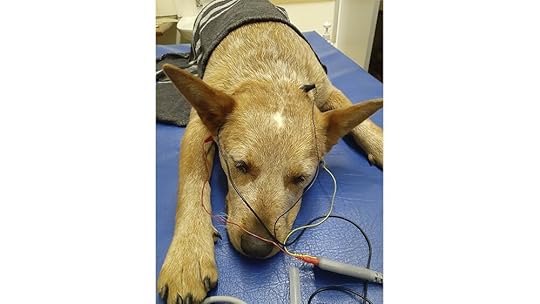
Sedated pup undergoing BAER test. Hogan and Georgia were not sedated and responded to all my words in American Sign Language. (While hand gestures were used with dogs, Hogan was among the very first deaf dogs to understand ASL. Tufts University staff was enthralled at their performance and became quite involved with Hogan over the years.)
Small electrodes are positioned on the animal’s head and connected to the device, which reads and interprets the brain’s response to a specific clicking noise generated by it.
Each ear is tested individually as the dog may only be deaf in one ear. If they can hear in the ear, the machine’s screen will show a recording of ‘waves’ of varying sizes and depths, but if they are deaf then the screen shows a recording of almost flat lines.
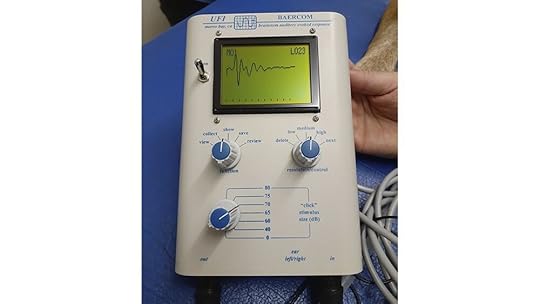
BAER Testing Machine
Once both ears have been tested, the sedation is reversed, and a copy of the results is shared with the owner.
Dogs with congenital deafness can be trained just like a hearing dog (using hand signals instead of speaking) and there are trainers who can assist with this. Many deaf dogs cope very well with hand signals, Pazzi says.
“Deafness in the dog – and cat – the population is low overall, but responsible breeders of predisposed breeds should ensure their puppies can hear and that deafness is not carried in their breeding lines,” he says.
Congenital deafness has been described in more than 80 breeds but is most commonly diagnosed in Dalmatians, Bull Terriers, Australian Cattle Dogs, English Setters, English Cocker Spaniels, and Boston Terriers. There is an association between deafness and pigmentation, with white dogs predisposed and even more so if they are white with blue eyes.
“It is important for dog breeders and people getting a puppy to make sure there is no congenital deafness in the line, particularly in breeds that are more susceptible to it. Other reasons for testing include owners who are concerned that the dog they have adopted is deaf, or if their elderly dog has become deaf.”
EDITED BY: CHANEL DE BRUYN
CREAMER MEDIA SENIOR DEPUTY EDITOR ONLINE
August 5, 2021
Hogan's Hope is for All Dogs' Good Health and Well-Being

Start slowly when brushing your dog’s teeth. Play with his or her mouth by gently putting your finger on their teeth. Progress to using your finger to brush until you can use a toothbrush.
5 Serious Illnesses Caused by Canine Dental DiseaseDental health is one of the most neglected issues in dogs. Yet, neglected teeth can quickly lead to canine dental disease other serious–and often fatal–diseases. Dr. Kathryn Primm, owner of Apple Brook Animal Hospital, and Dr. Denise Petryk, Director of Veterinary Services at Trupanion, shared with us some of the illnesses that can result from poor dental hygiene.
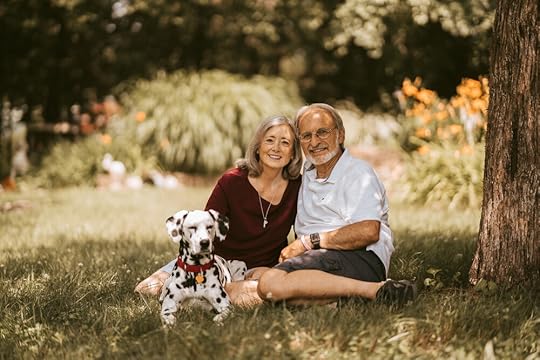
My deaf dog, Judea, is much too precious to us for her to develop any heart disease that could be easily avoided. Make the decision to be diligent and take good care of our four-legged family members.
1. Heart Valve InfectionsDr. Primm: “Mouth bacteria can travel and settle on the heart valves. Bacterial endocarditis (infection of the interior of the heart) is a problem of its own and can also permanently damage cardiac tissue and lead to heart disease and even heart failure.”
2. Liver Abscesses (Infections)Dr. Primm: “It is the job of the liver to filter things, so when bacteria in the mouth is swallowed, the infection can work its way to the liver fairly easily. Treatment is long and arduous. It’s also expensive and involves long-term treatment. This can be fatal.”
3. Sepsis (Blood Infection)Dr. Primm: “Mouth bacteria can get into the bloodstream and cause sepsis (a systemic infection that goes everywhere that the blood does–outside of the blood-brain barrier). Septic pets can survive but it’s a struggle and they will die if not aggressively treated.”

Listen to your veterinarian. Our wonderful Dr. Ouellette cared about our dogs as if they were his own.
4. Poor AppetiteDr. Petryk: “Bad teeth can be incredibly painful and lead to a decrease in appetite. Older, thin pets are at significant risk for additional weight loss, which can lead to organ failure. Sometimes it can be difficult to determine whether organ failure is due to bad teeth or another cause."
5. Osteomyelitis (Bone Infection)Dr. Petryk: “Severe dental disease can lead to bone infections and a broken jaw. Bone infection (osteomyelitis) is not only painful, but it can also lead to the life-threatening complication of a broken maxilla or mandible that might not heal. The bone under the teeth is susceptible to infection and becoming brittle. When this bone breaks, it is very hard for it to heal AND it is very difficult for veterinarians to fix some of these fractures.”
What Can a Responsible Pet Parent Do?The number one thing is to do almost ANYTHING - that is safe and healthy - you can to clean your dog’s teeth to prevent the possible onset of life-threatening canine dental disease. Yearly cleanings on top of daily brushing are what the vet will recommend. While some pet parents find it too difficult to brush their dogs’ teeth, alternatives are available to help keep tartar from building up in our precious dogs’ mouths. However, I believe that we need to avoid anesthesia as much as possible. BUT…do not choose not to have your dog undergo this option if the situation has gotten worse. Listen to your veterinarian.
I brush my deaf dog, Elsie’s teeth at least once a day and use a mixture of peroxide and water (50/50 ration). All my dogs. hearing and deaf, have had their teeth brushed from the beginning. The younger our dogs are when we start, the better. They learn to trust us and the toothbrush and get used to the routine. The morning seemed best for me and them. I even brushed their teeth before bedtime right after I brushed mine - makes it easy to remember!! Establishing a time every day helps us to remember and take that important minute to keep our dogs in tip-top health. I never stopped — no matter their age!!
If you can’t manage to brush their chompers even once a week, offering your pet the right kind of dental treats will definitely help maintain your pup’s teeth between cleanings and lessen their chances of developing canine dental disease. If you’re like some others and brushing your dog’s teeth is a trial if not impossible, then you’ll love the ease and the benefits of giving your dog toys and dental treats that are designed to help eliminate the plaque and bad breath. Your dog will be a happier dog as well. They don’t like scummy mouths any more than we do.
Make absolutely certain that the dog dental treats use only the highest quality ingredients to improve your dog’s dental health, along with other parts of their well-being, too. Your dog won’t even know these tasty snacks are cleaning their teeth and freshening their breath. Give your pup a shinier smile starting today!
Give your pup one a day for fresher smelling breath and cleaner teeth. Help maintain your pup’s smile and health!
Hogan's Hope is for All Dogs Good Health and Well-Being

Start slowly when brushing your dog’s teeth. Play with his or her mouth by gently putting your finger on their teeth. Progress to using your finger to brush until you can use a toothbrush.
5 Serious Illnesses Caused by Canine Dental DiseaseDental health is one of the most neglected issues in dogs. Yet, neglected teeth can quickly lead to canine dental disease other serious–and often fatal–diseases. Dr. Kathryn Primm, owner of Apple Brook Animal Hospital, and Dr. Denise Petryk, Director of Veterinary Services at Trupanion, shared with us some of the illnesses that can result from poor dental hygiene.

My deaf dog, Judea, is much too precious to us for her to develop any heart disease that could be easily avoided. Make the decision to be diligent and take good care of our four-legged family members.
1. Heart Valve InfectionsDr. Primm: “Mouth bacteria can travel and settle on the heart valves. Bacterial endocarditis (infection of the interior of the heart) is a problem of its own and can also permanently damage cardiac tissue and lead to heart disease and even heart failure.”
2. Liver Abscesses (Infections)Dr. Primm: “It is the job of the liver to filter things, so when bacteria in the mouth is swallowed, the infection can work its way to the liver fairly easily. Treatment is long and arduous. It’s also expensive and involves long-term treatment. This can be fatal.”
3. Sepsis (Blood Infection)Dr. Primm: “Mouth bacteria can get into the bloodstream and cause sepsis (a systemic infection that goes everywhere that the blood does–outside of the blood-brain barrier). Septic pets can survive but it’s a struggle and they will die if not aggressively treated.”

Listen to your veterinarian. Our wonderful Dr. Ouellette cared about our dogs as if they were his own.
4. Poor AppetiteDr. Petryk: “Bad teeth can be incredibly painful and lead to a decrease in appetite. Older, thin pets are at significant risk for additional weight loss, which can lead to organ failure. Sometimes it can be difficult to determine whether organ failure is due to bad teeth or another cause."
5. Osteomyelitis (Bone Infection)Dr. Petryk: “Severe dental disease can lead to bone infections and a broken jaw. Bone infection (osteomyelitis) is not only painful, but it can also lead to the life-threatening complication of a broken maxilla or mandible that might not heal. The bone under the teeth is susceptible to infection and becoming brittle. When this bone breaks, it is very hard for it to heal AND it is very difficult for veterinarians to fix some of these fractures.”
What Can a Responsible Pet Parent Do?The number one thing is to do almost ANYTHING - that is safe and healthy - you can to clean your dog’s teeth to prevent the possible onset of life-threatening canine dental disease. Yearly cleanings on top of daily brushing are what the vet will recommend. While some pet parents find it too difficult to brush their dogs’ teeth, alternatives are available to help keep tartar from building up in our precious dogs’ mouths. However, I believe that we need to avoid anesthesia as much as possible. BUT…do not choose not to have your dog undergo this option if the situation has gotten worse. Listen to your veterinarian.
I brush my deaf dog, Elsie’s teeth at least once a day and use a mixture of peroxide and water (50/50 ration). All my dogs. hearing and deaf, have had their teeth brushed from the beginning. The younger our dogs are when we start, the better. They learn to trust us and the toothbrush and get used to the routine. The morning seemed best for me and them. I even brushed their teeth before bedtime right after I brushed mine - makes it easy to remember!! Establishing a time every day helps us to remember and take that important minute to keep our dogs in tip-top health. I never stopped — no matter their age!!
If you can’t manage to brush their chompers even once a week, offering your pet the right kind of dental treats will definitely help maintain your pup’s teeth between cleanings and lessen their chances of developing canine dental disease. If you’re like some others and brushing your dog’s teeth is a trial if not impossible, then you’ll love the ease and the benefits of giving your dog toys and dental treats that are designed to help eliminate the plaque and bad breath. Your dog will be a happier dog as well. They don’t like scummy mouths any more than we do.
Make absolutely certain that the dog dental treats use only the highest quality ingredients to improve your dog’s dental health, along with other parts of their well-being, too. Your dog won’t even know these tasty snacks are cleaning their teeth and freshening their breath. Give your pup a shinier smile starting today!
Give your pup one a day for fresher smelling breath and cleaner teeth. Help maintain your pup’s smile and health!
July 13, 2021
Hogan's Hope on Stories That Empower

Connie was diagnosed with a degenerative nerve disease. She was introduced to a pup that was neglected, abused, beaten and starved. Connie saw opportunities that were endless through his eyes. She realized that there were no boundaries to his love and hope. This gave Connie inspiration to try. She came to learn hope and not give up. Connie shares these powerful nuggets of life wisdom:
- you are worthy of true love
- through our suffering, we develop perseverance
- perseverance leads to character
- character leads to hope
- let's strive to see our trials and tribulations as gifts
- great blessings belong to those that are sad
- the only way to multiply love is to divide it
- offer unconditional love
- be kind to yourself and others
- love yourself no matter what
- accept yourself despite your differences and because of your uniqueness
- believe that everything is possible for one who believes
- with hope, anything is possible
- children have pure, untarnished souls
- accept challenges with the confidence that you can succeed
- there's a difference between happiness and joy
- joy fills our hearts
- share hope with others
- accept the things we can change and those we can't
- being different makes us special and gives us strength
- be open to find hope in the most unexpected places
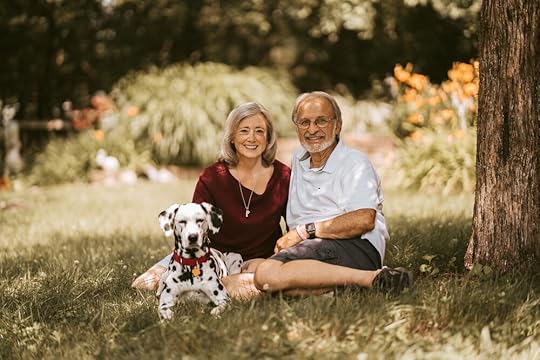
https://conniebombaci.com
https://www.facebook.com/ConnieBombaci
https://twitter.com/conniebombaci
https://www.instagram.com/conniebombaci
https://www.linkedin.com/today/author/connie-bombaci-1ab84b6a?trk=author-info__article-link
tags: Connie, Bombaci, Hogan's, Hope, writer, author, story, stories, that, empower, empowering, empowerment, inspire, inspiring, inspiration, encourage, encouraging, encouragement, hope, light, podcast, Sean
https://storiesthatempower.com
July 2, 2021
Fireworks Tips for our Hearing and Deaf Dogs
Deaf dogs, too, often suffer from vibrations, flashing lights, and high pitches of fireworks. What’s fun and entertaining for humans is not necessarily fun for our deaf dogs. Add to the commotion, dogs are often left alone to suffer in fear, not knowing why and what is occurring.
I am sharing the article provided by iHeart because I wholeheartedly believe that we MUST take every precaution possible to safeguard our dogs, hearing and deaf dogs, and provide for their calm environment.
The 4th of July is a fun celebration for humans, but for dogs, it often feels like it’s the end of the world. While we’re attending parties, our poor canines are left to hide under the bed alone. As if that isn’t sad enough, the 4th of July is also the time of year that most pets go missing. So, it’s time for us to make our furry friends a priority this holiday.
Here are nine tips to help you keep your canine calm and safe during the 4th of July.
Dogs usually like to be a part of things, but the 4th of July is one holiday they won’t mind missing. Instead of bringing them to crowded, noisy celebrations, it’s better to leave them home. Not only will loud fireworks scare them off, but there could be a lot of unhealthy food and other substances falling on the ground. Unfamiliar objects could be hazardous for your dog if they consume them. So, it’s best to keep your dog in a quiet, comfortable space that’s far away from the chaos.
You probably don’t want to miss out on the excitement of this holiday, but you staying home might be the best thing for your furry friend. Having someone familiar around to comfort them could ease their anxiety. If you act calm around your dog, they’re more likely to feel relaxed as a result. If you are unable to stay home that night, consider letting someone your dog trusts stay with them.
Even the best-behaved dogs could go missing on the 4th of July. If a dog gets spooked, they might keep running until they’re far away from the scary sound. So, it’s a good idea to prepare for the worst in this scenario. If your dog is wearing a collar with identification tags, along with an up-to-date microchip, it’ll be much easier for someone to bring them back to you if they’re found. It’s better to be safe than sorry when it comes to your loved one’s life.
If you usually leave your dog in the main room while you’re gone, you might need to switch it up. Find the quietest, most sound-proof room in your home and keep your dog there. Also, make sure the space you keep them in is secure, so they can’t sneak out. If your home is too close to local fireworks, consider having them stay at a friend’s house if it’s more peaceful. The quieter the fireworks are, the less likely your dog will try to escape.
Once you find a quiet space for your dog, you can use white noise to drown out the fireworks even further. Turn on a radio, TV, or fan near your dog. Certain music genres can even have calming effects for dogs. So, take advantage of some white noise to distract your pup from the unusual sounds outside.
#6 – Exercise Them BeforehandWhile it’s still light outside, you should exercise your dog as much as possible. Take them for a long walk to tucker them out before the fireworks start. When you go outside, make sure your dog’s harness fits properly, and their leash is securely clipped in. Of course, if it’s hot out, you might need to take several shorter walks instead to avoid heatstroke. After a nice stroll, your dog will sleep better, hopefully distracting them from the fireworks.
#7 – Provide a DistractionSleep isn’t the only distraction you can provide for your pooch. Puzzle toys, such as toys filled with treats or smaller squeaky toys, are great for keeping your canine’s mind busy. Playing games with your dog or giving them something to chew on can also distract them. Just make sure that you’re keeping an eye on them while they play to avoid choking.
Some dogs will freak out every 4th of July, no matter how many times they’ve experienced it. If you want this annual anxiety to end, you might need to work on some training. Try playing sounds of fireworks while rewarding your dog with something they love, like their favorite treat. Your dog might learn that fireworks aren’t a threat. If you’re having trouble with this, consult a vet or dog trainer for professional advice.
Even if you’ve tried everything, your dog might still be overly anxious on the 4th of July. So, many dog parents try CBD for dogs to help soothe that nervousness. Cannanine Organic Hemp CBD is a great option for canines. CBD products can calm your dog and help them feel more comfortable without causing the side effects of medications. Plus, there’s no THC in Cannanine, so you know it’s safe and will not make your dog feel “high.”
Please! Pay attention and give our dogs, hearing and deaf, the care and love that they need. They ask very little from us. We are their guardians. Keep them secure. Give them love.
June 11, 2021
Safety for Dogs in Extreme Weather
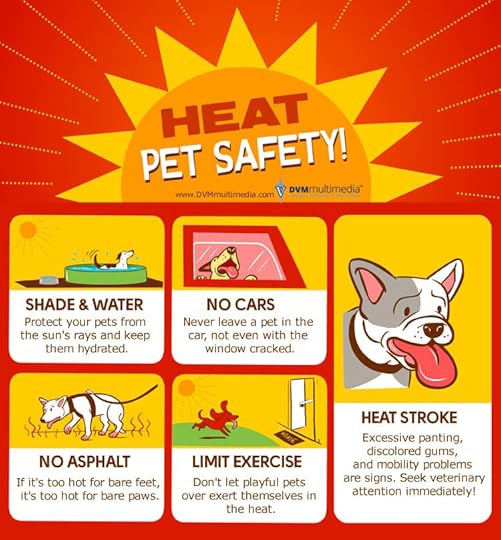
I posted this information two years ago but it is worth repeating in order to remind everyone how dangerous things can get in the hot summer temperatures. Watching the screen on our weather station located in our front yard, my heart sinks thinking of all the animals outside in the rising temperatures. Too many are left unattended, provided with an insufficient supply of fresh, cool water, shade, or comfortable shelter, and chained to a tree or stake. Why do these people have a pet? Would they like to be chained for hours? Do they care about their dog who depends on them for life's essentials, including real love and genuine care?
The following is a reprint of an article from FOX59 news. The additional requirements of the ordinance are good, but I would like to see them go further. The consequences need to carry a bigger penalty that bites into the human’s purse and personal comforts. Perhaps they should experience what they put their precious pets through. At the least, the pups need to be taken out of the home. Children are taken from unsafe environments, and we need to protect the ones without voices - we must be their voices and protectors.
“Indianapolis, Indiana has a new addition to the Indianapolis Animal Care and Treatment Ordinance that defines the extreme low and high temperatures at which point dog owners must bring their dog inside a temperature-controlled facility.
The new rules were added to the Care and Treatment of Animals ordinance in September 2015, and this is the first summer they are in effect.
According to the ordinance, it is now required by law to provide your dog with shelter when the temperature reaches 80 degrees Fahrenheit, and you must bring your dog inside when it’s warmer than 90 degrees Fahrenheit.
The law also sets new requirements for tethering and enclosures. Here is a complete list of the improvements made to the ordinance, as provided by Friends of Indianapolis Dogs Outside (FIDO):
Shelter
Your dog must have access to:
A shelter constructed of solid wood or other weather-resistant materials consisting of solid walls on all sides
A dry floor raised above the ground
A roof sloped away from the entrance to protect your dog from weather and extreme cold
Pen or Fenced Enclosure
Your dog must have adequate space for exercise when confined to a kennel, enclosure or pen which must be at least 100 square feet (for example 10ft. x 10ft.)
Any dog over 80 pounds must be provided with a space of 150 square feet
For each additional dog inside the enclosure, an extra 50 square feet must be provided
Tethering
It is against the law to tether (chain) your dog if any of the following is true:
Your dog is less than 6 months old
Your dog is sick or injured
It is between 11 p.m. and 6 a.m.
Your dog is not spayed or neutered, unless you are an adult, your dog is in your visual range, and you are outside with your dog
Extreme Weather
Your dog must be brought inside a temperature-controlled building, such as your house when:
The temperature outside is 20°F & below
The temperature outside is 90°F & above
There’s a heat advisory
There’s a wind chill warning
A tornado warning has been issued
Shade
On any day where the temperature is at or above 80°F, your dog’s shelter must be shaded by either trees or a tarp.
"The new ordinance does not prohibit people from walking their dog or letting their dog outside to relieve themselves. The new ordinance is targeted at situations where dogs are otherwise living in extreme temperatures 24/7 or close to it," said Darcie Kurtz of FIDO.
A person who violates any part of this ordinance will receive a $25 fine for the first violation and a $200 fine for the second or subsequent violations. Additionally, a court may decide to take the dog away from the pet owner.
According to the Humane Society of Indianapolis, unlike humans, dogs are only able to perspire around their paws which is not enough to keep their body cool.
Some signs of heatstroke are panting, staring, anxious expression, refusal to obey commands, warm, dry skin, high fever, rapid heartbeat, vomiting, and collapse. If your dog experiences any of these symptoms, call a veterinarian immediately and lower the animal’s body temperature by applying towels soaked in cool water to the hairless areas of the body.
June 1, 2021
Hogan's Hope funds Connie Bombaci Service Award
Haddam-Killingworth Seniors Recognized for Service
*FOR IMMEDIATE RELEASE**
Haddam-Killingworth Seniors Recognized for ServiceHADDAM-KILLINGWORTH, Conn – Jasmine Byrne and Malone Revis received the 2021 Connie Bombaci Service Award during the Haddam-Killingworth High School's Senior Awards Ceremony on May 25th. This well-respected Award gained highly regarded recognition when created by former Superintendent Gary Mala and the Board of Education in 2006. Regional School District 17's purpose was to recognize Mrs. Bombaci's exceptional service to the school district over her years of commitment and devotion to the students, staff, and H-K community. Mrs. Bombaci passionately believed that all students learn to give back to others and share their time, talents, and themselves. This Award's purpose is to help ensure that the heart of "paying it forward" will continue to be present in our high school for many years to come.
This annual award recognizes a member of the graduating class who has demonstrated significant and genuine dedication to voluntary service to the Haddam-Killingworth High School and its community. An independent committee of select family and community members chooses the recipient. Because of the high caliber of the applicants this year, the committee members chose two extremely qualified beneficiaries.
Principal Donna Hayward spoke directly to the senior class during the ceremony on behalf of Mrs. Bombaci, reminding them that everyone must serve one another without expectation of personal gain but for lending the helping hand that makes a remarkable difference. Requirements to be considered for the Award include goals of continuing in a field that would further support others. Award winners may earn their education and training at the university or certification level.
This year's Award was presented to Jasmine Byrne and Malone Revis because of their outstanding efforts in helping and serving others. Both candidates dedicated themselves to almost 2s,000 combined hours of volunteering their talents and time to reach out and offer much-needed help to humans and animals alike.

Jasmine Byrne
Jasmine Byrne plans to attend the University of New Haven and earn her degree in forensic science. She states, "I love the idea of being able to use science in order to piece together information on a small scale." All of which will help serve the community in seeking pertinent information that will directly impact our safety at large. Among the many accolades, one included, "[She] gives me great faith in the youth of America. Her service to the communities of Haddam and Killingworth is well documented with a youth literacy program that she started." Jasmine also achieved the Girl Scouts Bronze Award by building over 100 birdhouses, the Silver for creating an educational exhibit and activity at Parmalee Farm to make yarn out of recycled plastic bags, and the Gold Torch Award establishing a long-lasting and sustainable education program. The Gold Torch is the Girl Scout's highest award, an extremely prestigious award.

Malone Revis
Malone Revis will be attending the University of New Hampshire to achieve his goal of becoming an accredited zoologist to rescued and severely needy animals. Malone has already experienced a fantastic repertoire of opportunities to work with and save a wide variety of species. By working within the facilities, he has respectfully gained firsthand, hands-on experience that encouraged him to continue to ensure good animal welfare, conservation, and education. He ardently believes in second chances and quality of life no matter the species. "Malone has been a vital part of the Mystic Aquarium team and has shown incredible initiative as a docent, which earned him a competitive spot as a husbandry volunteer."
Funding for this Award is now made possible through profits received from Bombaci's international multi-award-winning book, Hogan's Hope: A Dear Hero’s Inspirational Quest for Love and Acceptance and its accompanied Christian edition and two children’s books. It's the inspirational story of an amazing deaf dog serving others as a certified therapy dog and paved the way for other deaf animals to be saved. Endorsed by Dateline NBC's correspondent, Dennis Murphy, and the foreword written by the renowned animal behaviorist, Dr. Nicholas H. Dodman of Tufts University, this book provides an excellent incentive for genuine acceptance, pure love, and worthiness, no matter what. Bombaci stated, "Hogan taught me how to live my life as a courageous journey and with unconditional service to others. I determined that his life was going to be 'A gift that keeps on giving.'"
(Photographs provided by the recipients, Jasmine Byrne and Malone Revis.)



